
Social Dance Timeline
For those who enjoy information concerning the history & culture of dance and music.

The primary dance of the Burgundian court was the stately Bassedanse.
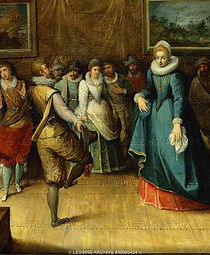
Pavan at the Spanish Court
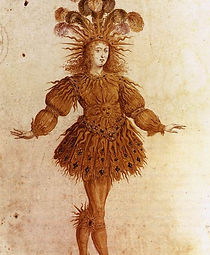
A costume design for Louis XIV as The Rising Sun, from the final entrée of Le Ballet de la Nuit (1653).
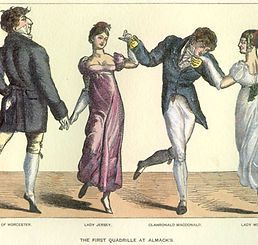
English Country Dancing
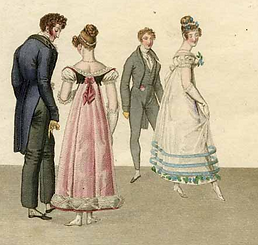
In the Regency period, steps ranging from simple skipping to elaborate ballet-style movements were used
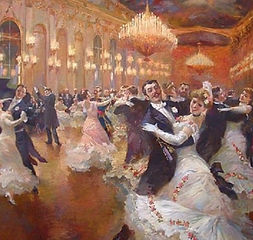
The advent of the Waltz in polite society was the greatest change in dance form and dancing manners that has happened in our history.

The Waltz originated as a folk dance from Austria and is derived from the old German word "walzen" meaning "to roll, turn", or "to glide".

The Cakewalk was a dance developed from the prize walks held in the late 19th century, generally at get-togethers on slave plantations in the Southern United States.
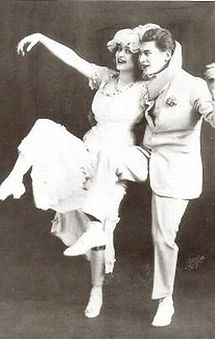
The Grizzly Bear Dance circa 1912

Irene and Vernon Castle
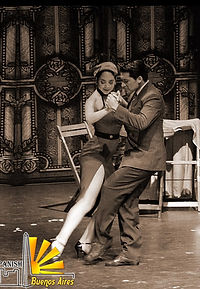
Argentine Tango

1950's Rock'n'Roll
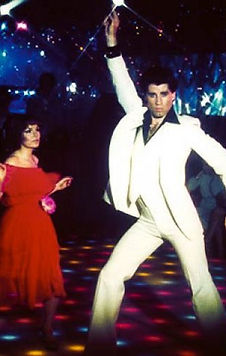
John Travolta in Saturday Night Fever
1977

1980's Linedance
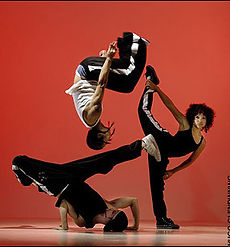
Hip Hop Dance
Dances of the Early Renaissance (15th Century)
The 15th century is the first period in western history to have dances documented well enough for reconstruction. Several surviving manuscripts describe the dances of the aristocracy, for whom dance was an important courtly pastime. The dances from the northern courts (primarily Burgundy – a large area north of the Alps including some of present-day France, Germany and the Netherlands) tended to be conservative and Gothic. Southern France (Provence) was more innovative, while Italy was the hotbed of the avant garde.
Dances of the Late Renaissance (16th Century)
In contrast to the two dance forms of 15th century courts, a great variety of dances arose in the 16th century. These included a continued evolution of the ancient peasant Branle (Brawl, Brando), Pavan, Spanish Pavan (Pavaniglia) with its intricate footwork, the virtuoso Galliard (Cinque Passi, Cinq Pas, Sinkapace), Tordion, the risqué Volta, the stamping Canario (Canary), Moresque (Mattachins, sword dances), Alman, Coranto, Gavotte, Torneo, Battaglia and many varieties of the Ballo. Some dances, especially the Balli, were constructed mathematically, to appeal to reason and science, which were regarded as arts. Figures traced on the floor had well understood meanings at the time (triangles, spirals, interlocking rings) so that subtle messages could be conveyed through gestures and patterns. Unfortunately, many of these meanings are lost today.
Regional dances were diffused throughout Europe by arranged political marriages and their attendant multicultural festivities. Dances were also exchanged between the courts and countryside: aristocratic dances "sank" into the lower classes over time, much as clothes were handed down as they wore out, and at the same time some of the more interesting peasant Branles, observed in the countryside, were brought into the courts.
As in the 15th century, the favored dance masters were usually Italian. Although the balance of political and commercial power was shifting to England, France and Spain, these courts still preferred to dance in the Italian style. Italian dance had the same prestige in the 16th century that French court dance had in the Baroque era. Dance instruction books continued to be written by professional dance masters (usually Italian) and for the first time were reproduced and distributed widely, due to the advancement of printing methods. Fabritio Caroso of Sermonetta (near Rome) and Cesare Negri of Milan wrote detailed and comprehensive dance manuals, while Livio Lupi of Palermo wrote specialized handbooks on the galliard.
Baroque Dance (17th & 18th Century)
The French Noble style
A costume design for Louis XIV as The Rising Sun, from the final entrée of Le Ballet de la Nuit (1653).
The great innovations in dance in the 17th century originated at the French court under Louis XIV, and it is here that we see the first clear stylistic ancestor of classical ballet. The same basic technique was used both at social events, and as theatrical dance in court ballets and at public theaters. The style of dance is commonly known to modern scholars as the French noble style or 'belle danse' (French, literally "beautiful dance"), however it is often referred to casually as baroque dance in spite of the existence of other theatrical and social dance styles during the baroque era.
English Country Dance
The origins of English country dance are a matter of some debate. Shared features with other English folk dances, such as morris and sword dancing, suggest a true 'country' origin; however, other aspects resemble the courtly dances of Continental Europe, especially those of Renaissance Italy. It is probable that English country dance is the result of some synthesis of these dance forms. While many references to 'country dancing' and titles shared with known 17th-century dances appear from the reign of Elizabeth I forward, few of these can conclusively be demonstrated to refer to English country dance. Little of substance, therefore, is positively known of the form before the mid-17th century.
Published instructions for English country dances first appear in The English Dancing Master of 1651, issued by John Playford, a London music publisher. These dances, like most dances of the period, are unattributed. Playford and his successors had a practical monopoly on the publication of dance manuals until 1711, and ceased publishing around 1728. During this period, English country dances took a variety of forms, including finite sets for two, three and four couples as well as circles and squares. By the 1720s, these had been almost entirely supplanted by longways sets for three and two couples, which would remain normative until English country dance's eclipse.
The minuet was the most fashionable dance in the late 18th century ballroom. It was danced in the baroque or 'noble' style, which developed initially at the court of Louis XIV and was introduced to Britain by Charles II.
Most baroque music was dance music, and so terms such as minuet, sarabande, gigue, bourrée and gavotte refer both to a type of baroque music, and to the dances that were performed to them.
The 'noble' style was danced both socially, by ladies and gentlemen in the ballroom, and professionally, by actors and dancers in the theatre.
By the early 19th century, new dance forms from the Continent had begun to reach England and America. As the quadrille and waltz became increasingly popular, English country dance declined, and by 1830 had almost entirely vanished from society ballrooms.
Contradanses
An 18th century ball began with the formal dances, but later in the evening everyone let their hair down with the contradanses (country dances). These were simple and lively, and had a reputation for being danced with careless abandon and even amorousness!
If the formal dances were your chance to show off your dancing skills, the country dances were your chance to socialise. Instead of being choreographed for a fixed number of dancers, the country dances were generally for 'as many as will'. Fashionable new minuets were constantly being created, but the country dances were usually old favourites that everyone knew.
How do we know? Our knowledge of baroque dance comes largely from treatises and manuals written by 18th century dancing masters.
Social Dances of the 19th & 20th Century
Following the fall of the Ancien Regime in 1789, social dancing became more natural and egalitarian. Both clothing and dancing became less elaborate and restrictive as the rigid formalities of the Baroque ballroom eased.
19th century social dance can be seen as three eras, each with its unique clothing, manners, music and dances:
The Regency Era
This term, referring to the English Prince Regent (1811-1820), is sometimes used informally to refer to the wider period between 1800 and 1830. In England and France, the most popular new dance of 1815 was the Quadrille, created from older French Contradanse and Cotillon figures. The Quadrille was performed with a wide variety of rapid, skimming steps, such as the chassé, jeté assemblé and entrechats. English Country Dances, the Scotch Reel and Mazurka also featured intricate steps, and added variety to an evening's dancing. These set dances, done in formations of squares and lines, were joined by an unusual novelty performed by individual couples: the Waltz, which had risen from peasant origins to society assembly rooms. However the Waltz was more often discussed than actually danced at first. After centuries of dancing at arm's length from one's partner, much of genteel society was not ready to accept the closed embrace of the Waltz.
Shocking many when it was first introduced, the waltz became fashionable in Vienna around the 1780s, spreading to many other countries in the years to follow. It became fashionable in Britain during the Regency period, though the entry in the Oxford English Dictionary shows that it was considered “riotous and indecent” as late as 1825. The waltz, and especially its closed position, became the example for the creation of many other ballroom dances. Subsequently, new types of waltz have developed, including many folk and several ballroom dances.
The flowering of the Romantic Era
While the Waltz received a great deal of criticism, as "leading to the most licentious of consequences," it slowly made some inroads into the ballroom, aided by the occasional performance by a notable society figure. Waltzing jumped ahead in acceptability when its inherent sensuousness was tempered with a playful exuberance, first by the Galop and then by the Polka. The Polka from Bohemia became an overnight sensation in society ballrooms in 1844, eclipsing the Waltz at the time. The Polka's good-natured quality of wholesome joy finally made closed-couple turning acceptable, introducing thousands of dancers to the pleasure of spinning in the arms of another. Once they tasted this euphoria, dancers quickly developed an appetite for more. The Polka mania led to a flowering of other couple dances, including the Schottische, Valse à Deux Temps, Redowa, Five-Step Waltz and Varsouvienne, plus new variations on the earlier Waltz, Mazurka and Galop. Meanwhile, the increasing trend toward ease and naturalness in dancing had eliminated the intricate steps from the Quadrille and country dances, reducing their performance to simple walking.
The overall spirit of this era's dancing (1840s-1860s) was one of excitement, exuberance and gracious romance. The dances were fresh, inventive, youthful and somewhat daring. Society fashions were rich and elegant, but continued an emphasis on simplicity. By the 1850s, the ballroom had reached its zenith.
The High Victorian Era
By 1870, social dances were now those of one's parents, or even grandparents. The ballroom was slowly becoming the domain of high society's Old Guard. As dancing become less exciting, fewer people devoted themselves to mastering the full repertoire of dances. One-by-one, the Mazurka, Schottische, Redowa and Polka began to fade. Dance masters formed professional associations in an attempt to save their trade, but these organizations mostly resulted in the standardization and codification of dance steps, which further dampened the public's enthusiasm. Dance masters invented dozens of new steps in an attempt to revive interest, but the public remained largely indifferent. High society balls shifted their emphasis to the "German" parlor cotillion games, featuring expensive favors (prizes). Middle class public balls saw the great variety of dances dwindle to just two: the Waltz and Two-Step. By the end of the century, dancers were ready for something completely different. After centuries of innovations created by European leaders of society, they would not have guessed that the next wave of popular dance and music would come from America's lower classes.
The Ragtime Era
Music: During the 19th century, most of America's music, dances and fashions were imported from Europe, as composers and dance masters emulated the latest styles from Paris and London. At the same time, the American slaves from Africa were combining their native music with European forms, resulting in their spirituals and "Ethiopian Melodies" that were adopted by minstrel shows and American composers like Foster, Christy and Gottschalk. During the 1890s and early 1900s this unique African American music developed into a new sound – syncopated Ragtime music.
Dance: At the end of the 19th century, many Americans were becoming bored with the old music and dances, which were essentially those of their grandparents. In the early 20th century, traditional and historical dances began to be revived in England. The Twentieth Century was seen as a time to make great changes, so most people were ready for innovations, probably with the expectation that the changes would come from society's cultural leaders. But instead, many Americans began to find it "modern" to dance their Two-Step to the new Ragtime music from the rural South and Midwest. Some high society ballrooms embraced the African American Cake Walk as "the popular fad of popular society." In the early 1900s, Ragtime music gained a wider acceptance and was soon accompanying the new Four-Step (soon to be re-named the One-Step) and a spontaneous menagerie of "animal dances" such as the Grizzly Bear, Turkey Trot, Bunny Hug and Camel Walk, especially among the lower classes. By 1910, the popular phrase was, "Everybody's Doin' It Now," but in fact most of middle and upper class society was only talking about it. Many could not yet accept the new ragtime dances because of lower-class associations
In 1911 the newlyweds Irene and Vernon Castle found themselves in the right place at the right time, exhibiting their versions of the new American dances in a Parisian dinner club. They became immensely popular in Paris, and their fame spread through Europe. When the Castles returned to Irene's New York home in 1912, their dancing set a new prototype for Americans to follow. The Castles were a young, elegant, attractive, wholesome, married couple who had become the rage of Parisian high society. In a word, they had class. If they could dance the new ragtime dances with propriety, then all levels of society could, and did. The Castles were joined by other exemplars, such as Joan Sawyer, Maurice Mouvet and Florence Walton, all becoming catalysts in an explosive new dance mania. And after two centuries of Americans dancing in the European manner, Europe was now importing the latest music and dances from America.
World War I brought an end to the ragtime era dance craze in 1914-15. Dance floors thinned as men in Europe and then America left for war. Vernon Castle joined the Royal Flying Corps. But for a brief four years, the "modern dancing" craze redefined social dancing for the new 20th century, while also
changing prototypes for personal relationships, both on and off the dance floor.
Dances of the Jazz Age
Within weeks of the Armistice, both Europeans and Americans were dancing again with renewed enthusiasm. In Paris, the wartime ban on public dancing was still in effect at the end of 1918, but that didn't stop the French from dancing. Many balls were given by the various regiments, with even more "private" tea dances held by the numerous dance teachers. By 1919 dancing in Paris had fully returned to its pre-war frenzy. The Dancing Times reported that Parisians "apparently cannot take a meal or watch a play through without breaking off for a round or two of dancing."
During the pre-war Ragtime Era, many young Americans had been chastised by their elders for a number of violations against decency, including using slang, dancing low-class dances, and enjoying syncopated music with African American influences. Progressive women were especially criticized, for abandoning the corset, wearing shorter skirts that exposed their ankles, cutting their hair short, and leaving the "separate sphere" of their domestic domain to be socially and politically active in the public arena. As in the later transition from the 1950s to 1960s, this repression led to a backlash.
During the Roaring Twenties young Americans responded to this criticism by expanding on all of these "violations," with more outrageous slang, jazzier music and dance, shorter and flimsier dresses and shorter hair. And the efforts of the Suffragettes paid off when the Nineteenth Amendment, granting women the right to vote, was ratified in 1920. The separate spheres of the 19th century had been broken and the Flapper redefined modern womanhood.
Early versions of the Charleston had been staged in small theatrical productions but it became the new dance hit of the Twenties when it accompanied James P. Johnson's song "The Charleston" in the 1923 Broadway musical Runnin' Wild. The variety of Charleston variations exploded with the advent of Charleston contests, for both solo dancers and couples. Then as the Charleston craze began to fade, anxious dance teachers hoped a new fad would revive their business, and thus embraced the newer Black Bottom. But there was more promotional publicity from the effort than actual social dancing of the Black Bottom.
Other dances in the 1920s:
Waltz and tango continued, with slow waltz becoming a new trend, and exhibition tango adopting a more "gaucho" style under the influence of Rudolph Valentino. The Foxtrot became smoother than the trotted ragtime version, or could be bounced even more vigorously, becoming the Toddle. The Brazilian Samba was introduced in Paris in 1922, then spread. Blues expanded from a sidenote in 1912 to a major influence in American music during the twenties.
In the early 1920s a string of dance crazes swept the world, including jitterbug and the Charleston. Perhaps the most significant of all these early 20th century crazes originated in Argentina in the early 1900s. The tango swept the world in the late 1910s and early 1920s, sparking a worldwide craze that was fanned by its use in Hollywood movies, and the style was soon appropriated to become part of the standard dance repertoire.
The Wall Street Crash of 1929 ended the Jazz Age, as The Great Depression set in. Dancing continued, with notable inspirations on the Silver Screen. Dance marathons, continuing from the 1920s, now became a hopeful step up for financially struggling dancers in the early 1930s. Then by 1936 dancers were ready to cut loose again, with the new hits of the Shag, Big Apple and the late blossoming of Lindy Hop and Jitterbug.
The Tango was the first in a series of 20th century Latin music dance crazes that included the Merengue, the Samba, the Mambo, the Rumba, the Cha-Cha-Cha and, in the early 1960s, the Bossa Nova. Each new Latin style enjoyed massive popularity, and many transcended their fad status to become standardized styles in the repertoire of western popular dance tradition.
Latin dance styles also exerted a huge influence on the direction of western popular music; this was especially true of jazz, which was profoundly altered by the advent of the first wave of Latin music in the 1940s and then by the bossa nova craze of the 1960s, which also had a massive influence on American pop music.
Teen Dances of the 1950's
Teens' dancing during the 1950s was widely varied in steps and styling. Rock'n'roll simply called for different styles of dancing, some of which mirrored the strong backbeat of rock.
Terminology was just as varied as the dancing. This was called Jitterbug, or Swing, Lindy, the Rock'n'roll, Boogie-Woogie or Bop. The word Bop was new then so almost everything was called "the Bop," but that word usually referred to a family of low swiveling Charleston-like steps danced in place, sometimes without a partner. These changes continued when 1950s teen swing became the Hustle during the 1970s.
The Disco Lifestyle 1970's
Rarely does a dance movement fit so precisely within a decade. Seventies Disco was born on Valentine's Day 1970, when David Manusco opened The Loft in New York City, and it rapidly faded in 1980. When the Disco movement peaked in 1978-79, the demographic was predominantly white, heterosexual, urban and suburban middle class. But it didn't begin that way. For the first eight years, Disco was an underground movement. Then the film Saturday Night Fever (December 1977) helped turn the simmering subculture into a mainstream fad, resulting in a 30-fold increase in disco clubs.
Does it seem odd that over a million white, straight, middle class and suburban Americans flocked to discos which were initially gay, black and Latino scenes? No, because a core element of the disco scene was sophistication. Sophistication meant wanting to see oneself as personally evolved.
The new freedoms were also expressed on the dance floor. This could be the self expression of solo dancing or the many shades of the sexual revolution played out in partner dancing, dressed up with disco fashions which often emphasized sexuality, and accompanied by overtly sexual lyrics in the new music... songs celebrating macho men and foxy ladies, love machines and "doing it."
But soon Disco Fever became "last year's fad" – the sure death of any trend – and by 1980 it was proclaimed to be dead.
Disco lasted only a decade but it initiated several traditions that are still with us today, most notably in dance and dance music.
1) While rock music in the 1970s was becoming a sit-down medium, with the stars up on the stage in the lights and the audience listening in the dark below, Disco reversed this, putting the audience in the spotlight.
2) The music changed to support this figure/ground reversal. Song lyrics became intentionally uninteresting, while the rhythm become more insistently driving. Two decades later, both of these trends would be refined even further in the rave scene, when minimalist music was given a dance beat, becoming Psy Trance, while House music continued the disco diva tradition.
3) Disco brought the return of partnered dancing, after the drought of the 1960s when the Twist and other solo steps mostly replaced couple dancing. As former disco dancer Joan Walton phrased it, "In the counterculture 60s the woman's attitude was, You're not going to lead me anywhere, buster! Then people rediscovered that collaborating with a partner to make a neat move happen was fun!" So this was not actually a new change, but rather a correction to the extremes of an earlier change.
Linedancing 1980's
On the disco floors of the 1970's, the form of dance that we know of today as "linedancing" was most likely born. Of course, it was not until latter, in the 1980's, that the term "linedancing" was coined and used. These early 'linedances' from the 1970's included dances such as the "Bus Stop" and "Nut Bush". Like the linedance-contra crossovers of the 1960's, these dances were not choreographed and evolved on the disco dance floors, much as any disco/club dance evolves. Similar spontaneous linedances continue to appear - late in 2002 such a dance appeared in Europe to "The Ketchup Song" by Spanish group Las Ketchup. This 'club dance' is not to be confused with several linedances choreographed to the same song.
These early disco linedances were linedances in every sense of the word, as used today, with the exception that they were not intentionally choreographed. Arguably one can claim their appearance heralded the birth of linedancing, although it's probably more correct to say their appearance was the last of the labour pangs in linedancing's birth.
Birth
With the coming of the 1980's, linedances of a sort had already been around for quite a few years. But it was in the early 1980's that linedancing, as it would be recognised today, was born. In 1980 Jim Ferrazzano choreographed the "Tush Push", which is one of the most well known linedances today. It was, however, originally choreographed to 1940's big-band style music. This is the first known
choreographed linedance (as distinct from dances that 'evolved' on the dance floor)
Just how long has linedancing been around? That all depends on how loosely you consider the question. In a very loose sense, people have been doing dances that would not be out of place on today's linedance floors for 100's even 1000's of years - dancing has, after all, been a part of human culture since before recorded history and more than a few of those ancient dances contained all the elements of modern day linedancing. More recently, linedancing can be traced to some of the line-style folk dances of the European Middle ages. Again, some of those dances could be called linedances, but one could justifiably say that they are really just folk dances that could be seen as linedances. In the 1800's USA, some folk danced in lines, but these dances were contra dances, quite distinct from linedancing. In the 1940's Contra dancing started to diverge (it's still around today) - some of the Contra dances appearing in the 1940's to the 1960's were increasingly like linedances. One could argue these dances were the first linedances, although I'm inclined to view them as "missing links" between linedancing and contra dancing (tho' they are by no means missing). In the 1970's another step in the birth of linedancing was made with the advent of the "disco linedances" such as the 'Bus Stop'. Were these linedancing? One could argue both ways .. yes and no. In one sense, linedancing was born when the word itself was first used. Just when that happened and who was the first to use the term ... that is unknown. Certainly by 1980 when the 'Tush Push' was choreographed, linedancing existed. That is the
oldest known dance that is indisputably a linedance so, IMO, I would date the birth of linedancing to it's appearance - 1980. True, there are older dances which today are called linedances, but when they
came out they were considered Contra dances and, arguably, linedancing is just a particular type of Contra dancing, one that has come to have an identity and standing of it's own.
Hip Hop and Street Dance 1990's
The hip-hop dance style b-boying and the funkstyles popping and locking are some of the most popular street dance styles in African American culture. Those forms of hip-hop dance are the most prominently practiced street dances. These street dance styles are so common that commercialized versions have been professionally developed and choreographed for dance routines in pop, hip-hop, electronic, and R&B music videos. B-boying helped bring about street dance crew culture, whereby the dance crews would learn various street dance styles for impression and competition. These street crews usually perform in outdoor jams, leading to further styles of hip-hop dance. New Jack Swing (a.k.a. Swingbeat) was created in the 90's dance scene, which is also a respected style of streetdance. New Jack Swing is also a music genre, co-created by pioneers such as Teddy Riley.The commercialization of hip-hop dance continued into the 1990s and 2000s with the production of several other television shows and movies such as The Grind, Planet B-Boy, Rize, StreetDance 3D, America's Best Dance Crew,Saigon Electric & the Step Up film series.

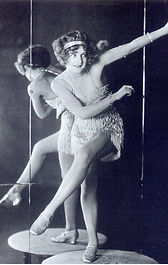
Rudolph Valentino Tango in 1921
The Charleston Dance circa 1923
